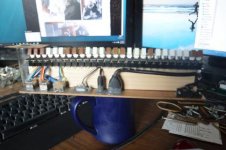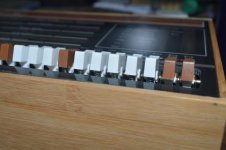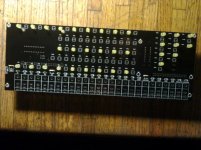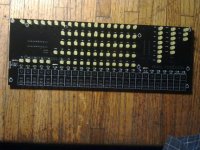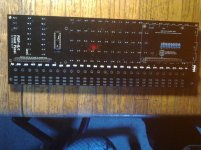Lou - N2MIY
Veteran Member
Hooray - We've got a second SLU as a real RS232 port
Hooray - We've got a second SLU as a real RS232 port
Today we are pretty well snowed in in the metro NYC area, which gave me time to get the second SLU added to the PiDP-8/i.
Jack, I ended up kludging together stuff that was easily available. The final suggestions of the gentlemen who responded earlier in the thread pointed me toward an FTDI FT232 based solution. I was really looking for only one more SLU, one for connecting a serial lineprinter, and so I went with something that gave me only one more SLU, however the approach can be expanded. The Microcenter has these Inland Products FT232 USB to RS232 adapters that are usually used for programming Arduino devices and I used one of those. So I have a USB cable plugged into the PI, going to the FT232 USB to RS232 adapter, and then a MAX232 connected to the FTDI adapter. That gets me to correct voltage level RS232.
In the PI, the bootscript needs to have a line added to tell SIMH what to do. The console is a KL8E, but if you want more SLUs, they will be KL8JA as device ttix. I only needed one more SLU, so to the bootscript I added:
attach ttix Line=0,Connect=/dev/ttyUSB0;300-8n1
Fortunately ttix looks like devices 40 through 47. I only needed 40/41, which is Line 0.
Under OS/8 on simh on the PiDP-8, I ran BUILD and LOADed and INSERTed the SLU2 handler. The KL8E handler can be compiled to make handlers for SLU2 and SLU3. I had already been through that exercise since on my real 8/e and 8/a, in addition to the console KL8E, I have a second KL8E at 40/41. So I already had an assembled SLU2.BN handler on the real machines. I copied it to RX01 and then read the RX01 on my PUTR PC that I have fitted with an 8" drive (so I can mount /RX01 /OS8 ). While under PUTR, I copied the SLU2.BN from the real floppy to an RK05 image that had BUILD that I would run on SIMH. [Did anyone notice that the default OS8.RK05 image with the PiDP-8 is missing BUILD? It seems to be David's diag-games-kermit.rk05 pack image.].
So with SLU2 added to the system head, and the hardware support attached in SIMH, I was able to COPY a text file out to SLU2 and it came out!! So now my PiDP-8 has two proper RS232 SLUs, one for the console terminal, and the other for the serial lineprinter (or Kermit, or whatever).
Tomorrow I will take a few photos, including the pen spring mod to the momentary front panel switches.
Lou
Hooray - We've got a second SLU as a real RS232 port
Today we are pretty well snowed in in the metro NYC area, which gave me time to get the second SLU added to the PiDP-8/i.
Jack, I ended up kludging together stuff that was easily available. The final suggestions of the gentlemen who responded earlier in the thread pointed me toward an FTDI FT232 based solution. I was really looking for only one more SLU, one for connecting a serial lineprinter, and so I went with something that gave me only one more SLU, however the approach can be expanded. The Microcenter has these Inland Products FT232 USB to RS232 adapters that are usually used for programming Arduino devices and I used one of those. So I have a USB cable plugged into the PI, going to the FT232 USB to RS232 adapter, and then a MAX232 connected to the FTDI adapter. That gets me to correct voltage level RS232.
In the PI, the bootscript needs to have a line added to tell SIMH what to do. The console is a KL8E, but if you want more SLUs, they will be KL8JA as device ttix. I only needed one more SLU, so to the bootscript I added:
attach ttix Line=0,Connect=/dev/ttyUSB0;300-8n1
Fortunately ttix looks like devices 40 through 47. I only needed 40/41, which is Line 0.
Under OS/8 on simh on the PiDP-8, I ran BUILD and LOADed and INSERTed the SLU2 handler. The KL8E handler can be compiled to make handlers for SLU2 and SLU3. I had already been through that exercise since on my real 8/e and 8/a, in addition to the console KL8E, I have a second KL8E at 40/41. So I already had an assembled SLU2.BN handler on the real machines. I copied it to RX01 and then read the RX01 on my PUTR PC that I have fitted with an 8" drive (so I can mount /RX01 /OS8 ). While under PUTR, I copied the SLU2.BN from the real floppy to an RK05 image that had BUILD that I would run on SIMH. [Did anyone notice that the default OS8.RK05 image with the PiDP-8 is missing BUILD? It seems to be David's diag-games-kermit.rk05 pack image.].
So with SLU2 added to the system head, and the hardware support attached in SIMH, I was able to COPY a text file out to SLU2 and it came out!! So now my PiDP-8 has two proper RS232 SLUs, one for the console terminal, and the other for the serial lineprinter (or Kermit, or whatever).
Tomorrow I will take a few photos, including the pen spring mod to the momentary front panel switches.
Lou
Last edited:

